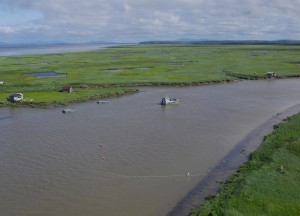A report released Wednesday by the EPA’s Inspector General found the agency’s work in Bristol Bay regulating the development of proposed mines like Pebble has been unbiased and done without a predetermined outcome.

While the EPA’s role is currently being challenged by Pebble in federal court, the agency is touting the IG’s report as validation of its direction and efforts.
EPA Region 10 Administrator Dennis McLerran has been noticeably quiet over the past year and a half, declining KDLG-Dillingham’s frequent interview requests. On Wednesday morning, however, with affirmation of his team’s efforts in hand, he was eager to get back out in front of a story in the now long-running saga of EPA versus Pebble mine.
“We feel very positive about the outcome and the findings,” McLerran said, speaking by phone from Oregon on Wednesday morning. “What the Inspector General confirms is that we conducted the assessment in compliance with all of our policies and procedures for ecological risk assessments, and that it was done appropriately, without bias and without prejudgment.”
McLerran added that he has been advised against making too many public statements, on account of the federal lawsuit currently in its discovery phase. The EPA has also been temporarily ordered by the judge against taking further action toward finalizing its preemptive restrictions in the Bristol Bay watershed.
The OIG evaluation, undertaken in May 2014, looked into whether McLerran’s staff had acted within EPA’s program guidelines, specifically between Jan. 1, 2008 and May 18, 2012. OIG staff interviewed more than two dozen people involved, but focused primarily on a keyword search of 8,352 emails of just three people: McLerran, who is Obama’s appointee to the office; Nancy Stoner, EPA’s former Acting Assistant Administrator for Water; and Phil North, the EPA ecologist who has since retired (and disappeared).
Pebble, which sent more than a dozen letters and hundreds of pages of documents to EPA’s Inspector General since the evaluation began, was quick to call it an “incredibly narrow investigation.”
McLerran disagrees.
“They did a very robust review of the communications back and forth, the correspondence, they did interviews, they looked at emails from a wide array of EPA employees and other folks including folks outside of EPA,” he said.
“Given the serious issues that were raised here, the report was laughable,” said Pebble CEO Tom Collier on Wednesday morning. Collier has decades of Washington, D.C., experience in and out of government, and said he was disappointed not only in the findings, but also in EPA’s OIG.
“To be only 30-something pages long, to not cite any of the really significant documents, it’s an outrage,” he said. “I don’t know what happened here, in this instance, but this report is clearly a whitewash, and I think it’s an embarrassment to IGs on good reputation around the country and at other agencies.”
The OIG’s report wasn’t all praise for EPA’s efforts. It cites problems with Phil North, including his role in helping draft the 2010 letter from Bristol Bay area tribes requesting EPA’s intervention. The report is also critical of North’s use of a personal email account for government business. His personal emails were not turned over to OIG, despite a subpoena. Plus, 25 months worth of his government emails through the 52-month period under evaluation are gone, allegedly erased when his computer hard drive crashed. North was interviewed once by OIG, near the start of the process, but ignored further requests and ultimately a subpoena.
Pebble, and federal court Judge H. Russell Holland, believe North was central to EPA’s intervention. McLerran said that’s not the case. “I want to be very clear, Phil North was not a central figure on this. I was a central figure, our Office of Research and Development scientists were central on this, the independent peer reviewers were central on this.” McLerran said the decision to initiate a 404c process was his to make, in consultation with EPA headquarters.
Pebble has put together a long paper trail documenting North’s involvement, which has so far been enough to convince Judge Holland to subpoena him to appear for deposition. North left the U.S. after retirement, and has ignored requests subpoenas and requests for information from Holland, Congressional committees, and EPA’s OIG. He is believed to be living in Australia or New Zealand.
“You know, I’m not surprised that Dennis McLerran, in order to save EPA’s decision, is throwing poor Mr. North under the bus,” said Collier. “It’s outrageous that that would be happening at EPA, but I guess that’s the only way they can defend their outrageous conduct here.”
The OIG’s findings were well received by supporters of EPA’s work to block development of Pebble. It’s been a while since that process has seen any progress or had any good news. What difference the report will make at this point, like the Cohen report before it, is unclear. Right now the outcome of the agency’s efforts seem destined to be decided in federal court, in Congress, or perhaps in the hands of the next administration.




